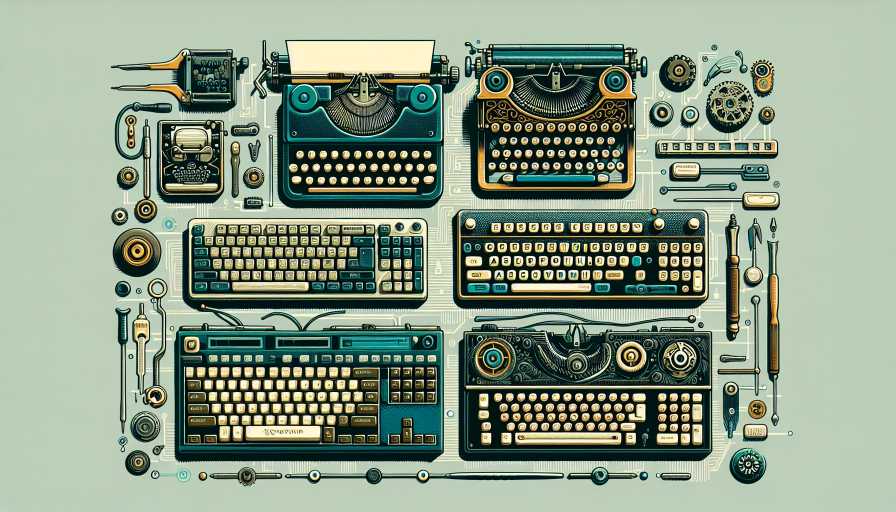# The Evolution of Keyboards: From QWERTY to Mechanical
Are you someone who spends a significant amount of time in front of a computer screen, typing away at lightning speed? Well, you're not alone! Typing has become an integral part of our daily lives, whether it's for work, communication, or leisure. And with the rise of typing tests and keyboard hardware, there's a lot to discover about the evolution of keyboards. So, buckle up and get ready to embark on a journey through time and geeky statistics as we explore the fascinating transformation of keyboards, from the iconic QWERTY layout to the mechanical marvels that dominate the market today.
# QWERTY: The Legacy Layout That Prevails
Most of us have never even questioned why the keyboard layout is the way it is. But did you know that the QWERTY layout, which has become the standard for keyboards, was actually designed to slow typists down? In the early days of typewriters, the mechanical machines often got jammed when people typed too quickly. So, Christopher Latham Sholes, the inventor of the typewriter, came up with the QWERTY layout in 1873 to tackle this issue.
The QWERTY layout was strategically designed to separate commonly used letters and discourage fast typing. This layout rearranges keys to minimize the chances of jamming by placing frequently used keys farther apart from each other. Interesting, isn't it? Despite its less-than-intuitive design, the QWERTY layout triumphed due to its early adoption and familiarity. And even in today's smart device era, QWERTY keyboards remain dominant.
# Enter the Ergonomic Era: Split and Alternative Layouts
As the world became more aware of the importance of ergonomics, keyboard designs began to evolve. Typists started complaining about discomfort and injuries due to the repetitive motion of typing. This led to the invention of split keyboards, where the keys are divided into separate halves to reduce strain on the wrists.
Additionally, alternative keyboard layouts gained popularity, challenging the supremacy of QWERTY. One such example is the Dvorak Simplified Keyboard, which aims to increase typing efficiency by placing commonly used keys on the home row. Although alternative layouts never gained widespread acceptance, they still have a dedicated fan base, eager to optimize their typing experience.
# The Rise of Mechanical Keyboards: For the Tactile Enthusiasts
While the majority of computer users became accustomed to the shallow and mushy feeling of membrane keyboards, a group of typing enthusiasts sought the joy of tactile feedback. And thus, the mechanical keyboard renaissance began.
Mechanical keyboards use individual switches for each key, making them more durable, responsive, and customizable. These switches, such as the renowned Cherry MX series, offer different tactile feedback and actuation forces. Typists can choose from a range of options, including linear, tactile, or clicky switches, tailored to their personal preferences.
But it doesn't stop at switches; the customization options are endless! From keycap materials, colors, and designs, to programmable macros and RBG lighting effects, mechanical keyboards have become a playground for enthusiasts seeking the perfect typing experience.
# Life Hacking through Typing Tests: Insights and Optimization
While some may consider typing tests as mere time-wasters, they can actually be valuable tools for self-improvement and optimization. Typing tests offer more than just a measure of your words-per-minute speed; they provide insights into your typing accuracy, rhythm, and efficiency.
By regularly taking typing tests, you can identify your areas of weakness and focus on improving them. Whether it's practicing specific keys or honing your ability to type without looking at the keyboard, these tests can help you achieve faster and more accurate typing skills.
Moreover, typing tests often come with features like personalized training programs, interactive lessons, and progress tracking. So, the next time someone scoffs at the idea of typing tests, tell them it's not only about speed, but a journey of self-improvement and optimization.
# In Conclusion
Keyboards have come a long way since Christopher Latham Sholes introduced the QWERTY layout. We've witnessed an ergonomic revolution, alternative layouts that challenge the norm, and the rise of mechanical marvels. And typing tests? They've evolved into tools for self-improvement and optimization, facilitating a faster and more accurate typing experience.
So, whether you're a casual typist, a developer, or a data-entry specialist, take a moment to appreciate the evolution of keyboards. Embrace your inner geek and explore the endless possibilities offered by keyboard hardware, typing tests, and life hacking.
